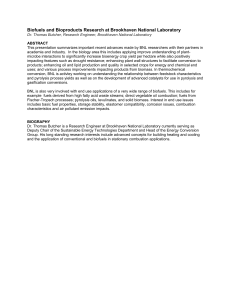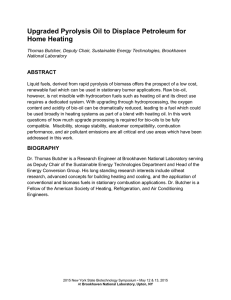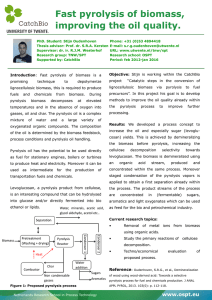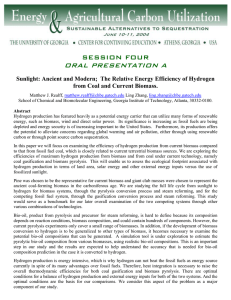Optimization of Empty Palm Fruit ... Production of Bio-oil
advertisement
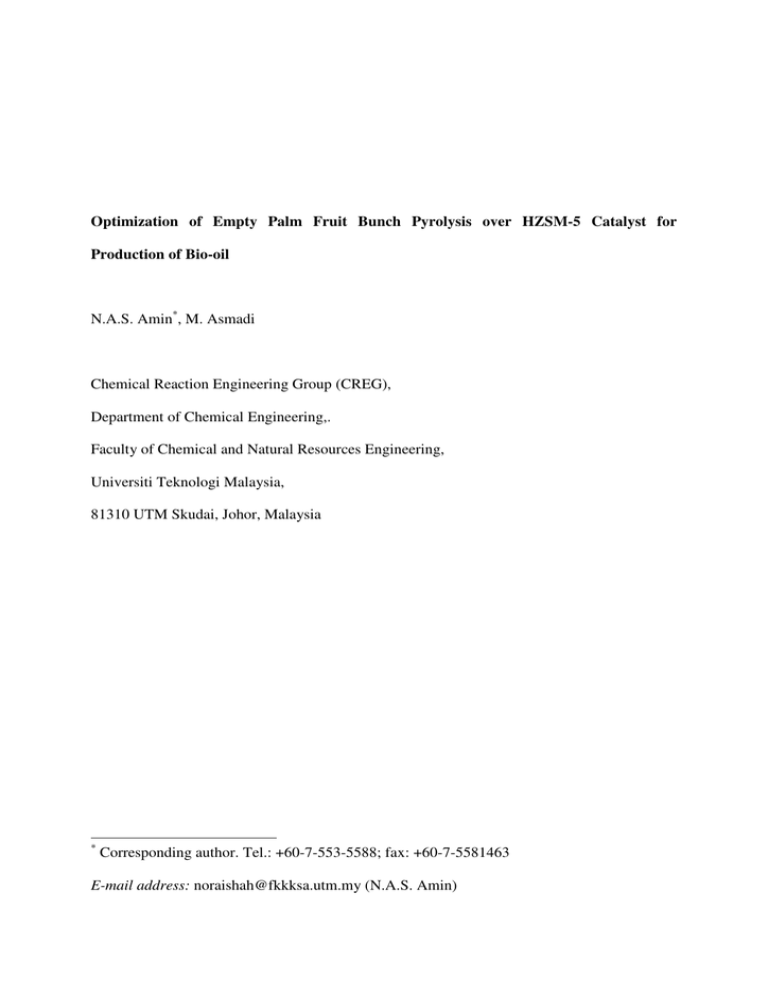
Optimization of Empty Palm Fruit Bunch Pyrolysis over HZSM-5 Catalyst for Production of Bio-oil N.A.S. Amin*, M. Asmadi Chemical Reaction Engineering Group (CREG), Department of Chemical Engineering,. Faculty of Chemical and Natural Resources Engineering, Universiti Teknologi Malaysia, 81310 UTM Skudai, Johor, Malaysia * Corresponding author. Tel.: +60-7-553-5588; fax: +60-7-5581463 E-mail address: noraishah@fkkksa.utm.my (N.A.S. Amin) Abstract The concerns over depletion of fossil fuel and security of energy supply have directed increasing awareness about biomass derived energy. Empty palm fruit bunch (EPFB), one of the major biomass available in Malaysia, is a potential source for fuel production. The objective of the present work is to determine the effect of reaction temperature and time on the optimization of EPFB pyrolysis to produce renewable bio-oil. A 22 central composite rotatable design (CCRD) was adopted in designing of experiments and response surface methodology was implemented. Experimental results were thoroughly analyzed by Analysis of Variance (ANOVA). The optimum product yield of 40.48 % was achieved at 573.15 K in 15 min while 0.057(g/g) of product selectivity was obtained at 623.15 K in 20 min. Keywords: Empty Palm Fruit Bunch (EPFB); Optimization; Pyrolysis; Bio-oil Abstrak Kebimbangan terhadap kemorosotan bahan bakar fosil dan keselamatan bekalan tenaga telah meningkatkan perhatian tentang tenaga terbitan biomas. EPFB, salah satu sumber biomass yang terdapat di Malaysia, adalah satu sumber berpotensi untuk penghasilan bahan bakar. Tujuan penyelidikan ini ialah untuk menentukan kesan suhu tindakbalas dan masa atas pengoptimuman pirolisis EPFB untuk menghasilkan minyak bio. CCRD dengan nilai 22 telah digunakan untuk merekabentuk eksperimen dan kaedah permukaan respons telah dilaksanakan. Keputusan eksperimen seterusnya telah dianalisis menggunakan analisis varian (ANOVA). Pengoptimuman hasil sebanyak 40.48% telah dicapai pada 573.15K dalam masa 15 min manakala kepemilihan 0.057(g/g) diperoleh pada 623.15 K dan 20 min. Katakunci: EPFB; Pengoptimuman; Pirolisis; Minyak Bio 1. Introduction The energy utilization from biomass resources (called biomass energy) has received much attention. Biomass contributes about 14% of the present world energy supply, while in many developing countries its contribution is about 35% [1]. Biomass is a mixture of three components (hemicellulose, cellulose, and lignin) and minor amounts of other organics. Each pyrolyses or degrades at different rates and by different mechanisms and pathways [2, 3]. Malaysia is one of the largest palm oil producers in the world, where more than 4.5 million tonnes of fibre, 1.9 million tonnes of shell and 7 million tonnes of EPFB at an increase of 5 % annually are generated as solid wastes [4, 5]. EPFB can be defined as the residual bunch after removal of the fruits; it constitutes 20% to 22% of the weight of the fresh bunches [6]. It can be used as compost for the oil palms while fibres from the oil palm fruits are used as fuel to fire the boilers to generate steam for the use in the palm oil mill. EPFB mainly consists of glucan, xylan, lignin and ash [7] is a potential source for production of bio-oil. Pyrolysis is degradation of biomass by heat in the absence of oxygen which results in the production of liquid, gaseous and charcoal products [8]. For pyrolysis of biomass, the whole process generally proceeds through a series of complex reaction pathway or divides into four ranges: where <220 °C is for moisture evolution; 220-315 °C for predominantly hemicellulose decomposition; 315-400 °C for cellulose decomposition; >400 °C for lignin decomposition [3, 5, 9]. Detail mechanism of biomass structural constituents (cellulose, hemicellulose and lignin) has been discussed in other literature [10]. The proportion of gas, liquid and solid products depend very much on the reaction parameters and pyrolysis technique used. In order to obtain maximum char with moderate amounts of tar by-products, slow heating processes over long periods of time is needed whilst high liquid yields can be obtained with high heating rates and short reaction time [11]. Previous investigations of biomass pyrolysis were mostly focused on the yield of solid, liquid, and gas products, as a function of variable parameters [5]. The liquid is a homogeneous hydrophilic (oleophobic) mixture of polar organics and water from both the pyrolysis reaction and the original water in the feedstock [2]. The objective of the present work is to determine the effect of reaction temperature and time for production of bio-oil from EPFB and to optimize the process for bio-oil yield. Batch reactions were carried out under various reaction temperature and reaction time. Response Surface Methodology (RSM) was utilized to optimize the principle variables which affected the conversion of EPFB to obtain high bio-oil yield. In order to achieve higher yield without heat and mass transfer limitations, thermal silicon oil was used in the batch reactor to facilitate heat transfer in reaction mixtures. 2. Experimental 2.1. Raw Material EPFB sample grounded to a particle size of < 3mm was obtained from Faculty of Mechanical Engineering, Universiti Teknologi Malaysia. The sample was first heated in the oven at 100-110 °C for 10 minutes to remove the moisture in the EPFB. Heat transfer oil (FOVAC® SSL Synthetic Heat Transfer Oil), was used as thermal oil to maintain the distribution of temperature. Meanwhile, HZSM-5-zeolite (Si/Al=30) was calcined in the furnace at temperature 550 °C for 4 hours. 2.2. Experimental Rig Set-up In this study, pyrolysis of EPFB was carried out in a cylindrical batch reactor heated by electrical furnace where the temperature of the pyrolysis reactor was adjusted by a Parr 4841 temperature controller. The desired amount of thermal oil, approximately 200 ml is placed into the batch reactor followed by 90 g of EPFB and 1.5 wt. % of catalyst (HZSM-5). The system from here on is totally closed to the atmosphere to prevent oxygen from entering the reactor by purging the reactor with inert nitrogen to ensure no oxygen or residual air in the system. An interval of 45 minutes was sufficient with a purge volumetric flow rate of 120ml/min. The experimental rig setup for EPFB thermal cracking is depicted in Figure1. 2.3. Analytical Methods Qualitative results of EPFB pyrolysis were obtained from Gas Chromatography-Mass Selective Detector. Gas Chromatography-Mass Selective Detector (GC-MSD) serves to separate mixtures into specific components using Agilent 19091S-433 column (30.0m×250µm×0.25µm nominal) and the mass spectrometer consists of three components which is the ion source, the mass filter and the detector. Helium was used as a carrier at a flow rate of 0.2 ml/min. All components in the system are controlled by a PC with a MS ChemStation software package. The following temperature program was adopted: initial, intermediate, and final temperatures were 80, 250 and 300 o C, respectively; times at initial were 0, 5 and 15 min, respectively. The liquid products were diluted with n-hexane and the injection volume was 0.2µl. 2.4. Design of Experiment The pyrolysis method was investigated by changing the mode of the reaction conditions which are temperature and reaction time (Table 2). The star low (-α (-2)), low (-1), centre (0), high (+1) and star high (+α (+2)) levels of all the independent variables corresponded to reaction temperature, X1; and reaction time X2. Accordingly, 473 K, 523 K, 573 K, 623 K, 673 K were chosen for variable X1 while 5, 10, 15, 20 and 25 minutes were chosen for X2. The analysis of data and generation of response surface graphics was performed by STATISTICA version 6 software (StatSoft Inc., Tulsa USA). After running the experiments and measuring the product yield, temperature and time of reaction, a second order model including interactions was fitted to the response data. In general, the response for the quadratic polynomials equation is described in Equation (1) k Y = β o + ∑ k β jX j =1 j + ∑ j =1 β jj X 2 j + ∑ β ij X i X j (1) i< j where Y is the predicted response, k the number of factor variables, βo the model constant, βj the linear coefficient, Xi and Xj are the uncoded the independent variables, βjj the quadratic coefficient, and βij is the interaction coefficient. In this work, the number of independent variables are two and consequently, k=2. The quality of fit of the second order model equation was expressed by the coefficient of determination R2, and its statistical significance was determined by an F-test. The significance of the regression coefficients was tested by a t-test. 3. Results and Discussion 3.1. Qualitative Results The EPFB pyrolysis was conducted over a temperature range of 473.15-673.15 K, reaction time in the range of 5-25 minutes and particle size <3mm. From the experiment, it was observed that the condensate produced heavy and light fractions. As a result, the liquid phase contained two layers where the upper layer was usually light yellow to brown while the bottom layer was dark brown to blackish. The upper layer can be considered as bio-oil fraction where some hydrocarbons existed in this layer. The bottom layer was purportedly water fraction because of its higher density and mostly polar components were contained in this fraction. Both fractions could not be mixed where a visible separation line was observed and bio-oil could be easily separated. After settling for one day, the final material was dark brown or blackish liquid with strong smell. The GC-MS analysis was carried out with typical pyrolytic oil in order to get an idea of the nature and type of compounds in the pyrolysis oil. There were 54 and 57 compounds identified in the upper and bottom layers, respectively. In general, bio-oil is a complex highly oxygenated mixture with a great amount of large size molecule, which nearly involves all species of oxygenated organics [12]. The results revealed that, most of the components identified in the upper layer are the phenolics, aromatics, esters, carboxylic acids, and long chain hydrocarbon groups. Additionally, small amount of ketones, aldehydes and nitrile are present and nearly all the functional groups showed extensive existence of oxygen. In the bottom layer the same compounds as in the upper layer are obtained including ketones, aldehydes and alcohols. The difference between the bottom and upper layers is the existence of long chain hydrocarbons in the upper layer. In addition, the bottom layer consists of more aldehydes and ketones than the upper layer which makes the bio-oil in the bottom layer especially hydrophilic and highly hydrated, which leads to the water being difficult to eliminate. Figures 2 and 3 showed the GC-MS chromatogram obtained from the pyrolysis of EPFB biomass for high yield and high selectivity, respectively. Table 1 and Figure 4 display the percentage quantified area for every identified peak and tentative desired compounds assigned, respectively. The results were obtained in the reaction conditions between temperature range 573.15-623.15 K and reaction time range between 15-20 minutes It can be seen that there are many compounds in the EPFB bio-oil with very low peak areas. As expected, the bio-oil is a very complex mixture of organic compounds and contained a lot of aromatics and oxygenated compounds such as carboxylic acid, phenols, and ketones [13]. Phenols are the major components in both layers with percent area of 48.7% and 25.8% for bio-oil yield and product selectivity, respectively. The strongly polar phenol group induces the antioxidant characteristics as reflected by very little change of viscosity over time when stored in room temperature [14]. The presence of long linear chain (C10-C15) of hydrocarbons in the compounds also gives the bio-oil solubility in the range of diesel and light lubricating oils. The most abundant products found are phenolic, dodecanoic acid, 9-octadecanoic acid, and 1, 3-xylyl-15-crown-4, 2, 3-pinanedioxyboryl. However, peak areas such as 2-methylbenzofuran, 2-nonanone, and 1,2-benzenediol are low. More recently, it was reported that aliphatics fractions can be obtained from slow pyrolysis of rice straw [15]. Comparison between reaction conditions of 643.86 K, 573.15 K and 502.44 K for 15 minutes of reaction time indicate that more desired components such as hydrocarbons, alcohols, esters and carboxylic acid are observed at moderate temperature being 573.15 K. Apparently at temperatures lower than 573.15 K the heat is not high enough to break down the cellulose. Similar results were also reported where cellulose would start to decompose between 588.15-673.15 K [3, 5, 9]. In another development, rice straw that contained a higher percentage of cellulose and lower percentage of lignin compared to EPFB gave high percentage of diesel and kerosene range hydrocarbons at temperature and pressure being 693K and 13 MPa, respectively [15]. In this work, at a higher temperature of 643.86 K, the thermal silicon oil degraded and became thermally unstabled producing undesired components such as cyslotrisilixone hexamethyl and cyclotetrasiloxane octamethyl which contaminated the bio-oil mixture. At this condition the situation would lead to wax formation and subsequently higher value of pour point could be obtained for the bio-oil. The fuel properties as well as the chemical and physical properties of biomass pyrolysis oils depend on among others the nature of feedstock, temperature and reaction time. Demibars [16] has summarized the properties of typical biomass pyrolysis oil and we have made the assumption the properties of our biomass oil are within the range of the values reported in this reference. The effect of the temperature and reaction time with 1.5 wt. % amount of catalyst in the pyrolysis of EPFB was investigated in this work. The reaction temperature and time were varied in the range of 473-673 K and 5-25 minutes, respectively. The pyrolysis process, as tabulated in Table 3, is strongly dependent on temperature and reaction time. The design of experiment included the yield and selectivity defined as Yi and Si in accord with Equations (2) and (3) where, Yield, Yi = (weight of bio-oil poduct in i layer /weight of feed) × 100 (2) and Selectivity, S = weight of desired products/ weight of undesired products (3) The subscript i=1 denotes the bottom layer whereas i =2 denotes the upper layer. The desired products are found in the upper layer (components such as phenols, ketones, and long chain hydrocarbons) while the undesired products included the bottom layer and all undesired components such as cyslotrisilixone hexamethyl, and cyclotetrasiloxane octamethyl in the upper layer. 3.2. Single-Response Optimization of Upper Layer Yield In this part, the optimal factors of temperature and reaction time were investigated to obtain the maximum yield of the upper layer product. The parameters of the second order model were determined by multiple regression analysis technique. By considering the coded levels and the real factor levels, the model developed is an empirical relationship between the upper layer yield, Y2 and the test variable as given in Equation (4) in coded unit and tabulated in Table 5. Y2 = −1052.21 + 3.4647 X 1 + 2.71 X 2 − 0.0029 X 12 − 0.2893 X 22 − 0.0098 X 1 X 2 (4) By using analysis of variance (ANOVA) and regression analysis, the quality of response function and experimental data can be checked in order to fit the quality of upper layer product yield as revealed in Table 4. For this second response (Y2), the determination coefficient (R2) obtained was 0.9496 which explained 94.96% of the variability in response and did not show any lack of fit. The response function and experimental model fitness was also tested with statistic Fvalue and compared to the F(α, p-1, N-p) -value tabulated in Table 4. According to the ANOVA, the statistic F-value (F=81.3262) was large compared to the table value, F(0.05, 4, 5) = 6.26. The large F -value (Fstatistics) indicates that the variation in the response can be explained by the regression model equation and indicated that the fitted model exhibits no lack of fit at the 95% confidence level. The statistical significance of each coefficient was determined using both t-value and p-value in Table 5. In addition, the associated p-value is used to check whether Fstatistics is large enough to indicate statistical significance. A smaller p-value but larger t-value indicates that the model is considered to be statistically significant . From Table 5, the largest effects on upper layer product yield are linear term (X1) of reaction temperature, quadratic term (X12) of reaction temperature followed by quadratic term of reaction time (X22), at 95% of confidence level which implied higher t-value (3.2487, 3.1668 and 3.1415) and lowest p-value (<0.05). The linear term of reaction time (X2) and interaction between temperature and the reaction time (X1X2) seemed not to be significant to the total product yield. Comparisons between the predicted values, Yp (using model equations) and the experimental results (observed values,Yo), depicted graphically in Figure 5, showed the regressions model fitted fairly well with the experimental results. Estimation of upper layer product yield over independent variables X1 and X2 in terms of contour surface is displayed in Figure 6. The contour plots are model dependent and are useful for establishing desirable response values and operating conditions. In a contour plot, the response surface is viewed as two-dimensional plane where all points that have the same response are connected to produce contour lines of constant responses. The effect of reactor temperature and reaction time on the upper layer (bio-oil) yield is clearly shown in Figure 6 where the maximum and minimum upper layer product yield is 40.48% and 2.47% within15 minutes reaction time at 573.15 K and 502.44 K reaction temperature, respectively. The critical conditions obtained from Statistica software are tabulated in Table 6. 3.3. Single-Response Optimization of Upper Layer Selectivity In this section, the optimal variables of reaction temperature and reaction time were investigated to obtain the optimum upper layer selectivity. The result for upper layer selectivity according to the experimental design is given in Table 7 and expressed in the quadratic models in terms of coded variables (Table 8). By using multiple regression analysis technique, the upper layer selectivity response model is developed based on Equation (1) and is represented in Equation (5). S = 0.004399 + 0.000691 X 1 − 0.034268 X 2 − 0.000001 X 12 + 0.000192 X 22 + (5) 0.000051 X 1 X 2 The regression coefficients are estimated with the coefficient of determination R2 = 0.9904 indicates a good agreement between the predicted and experimental data (Table 7). It can also be checked by coefficient of correlation (R) in order to verify the good correlation between predicted and experimental data. The calculated F-value of upper layer selectivity is extremely higher than that of distribution table (F0.01,4,5= 15.52) at 1% level of significance. Evaluated F-test analysis of variance proved that this regression is statistically significant (p<0.01) at 99% confidence level. Effect on regression coefficient for upper layer selectivity model and significance parameters are sorted based on the t-value and p-value as tabulated in Table 9. With high tvalue and absolutely lower p-value, the corresponding coefficient is highly significant. The linear term of reaction time, and interaction between temperature and the reaction time (X2 and X1X2, respectively) in the model have the largest effect statistically on selectivity at 99% confidence level. The quadratic term of reaction time, (X22) also exhibited a considerable effect at 95% level with t-value of 4.1928 and p-value of 0.013776 indicating a specified statistical significance. The t-value (2.2342) and p-value (0.089198) revealed a moderate effect statistically at 90% level (p-value <0.01) for the quadratic term of reaction temperature, X12 . The linear term of reaction temperature (X1) is found not significant to the selectivity. Each of the observed values, Yo is compared with the predicted value, Yp calculated from model, and is tabulated in Table 9. The two-dimensional contour plot described by the model equation, (S) is represented in Figure 7. It indicated that the maximum of upper product selectivity reached 0.05 g/g approximately. The optimal 0.0576 g/g and minimum 0.0042 g/g values could be obtained by conducting the pyrolysis experiment for 20 and 15 minutes reaction time at 623.15 K and 502.44 K reaction temperature, respectively. It was noted from the response surface and tvalue and p-value analysis that high selectivity can be achieved with increasing temperature and reaction time. The model predicted a maximum response of 598.16 K and 10.49 min for optimum hydrocarbon selectivity (Table 10) which should be verified experimentally. 4. Conclusions The pyrolysis of EPFB biomass using HZSM-5 and thermal silicon oil as a heat medium under various operating conditions is reported. A 22 central composite rotatable design was successfully adopted in experimental design and analysis of results. The adequacies of second-order polynomial equation models were evaluated via the analysis of variance (ANOVA) and the results showed that these models gave good estimation of the yield and selectivity. The optimum product yield of 40.48% of bio-oil was achieved at 573.15 K and 15 min while selectivity of 0.0576(g/g) desired products was obtained at reaction condition 623.15 K and 20 min. In order to get maximum yield the critical value that can be used for reaction condition is between 573.15-623.15 K for temperature and 10-15 minutes for reaction time. Acknowledgement The authors would like to express their sincere gratitude to the Ministry of Science, Technology and Innovation (MOSTI) Malaysia for providing the research grant under escience project no 02-01-06-SF0074 (vot 79049). Exposure to EPFB pyrolysis by BnB Limited is also highly appreciated. References [1]. M.M. Küçük, A. Demirbaş, Biomass Conversion Processes, Energ. Convers. Manage. 38 (1997) 151-165. [2]. A.V. Bridgwater, D. Meier, and D. Radlein, An Overview of Fast Pyrolysis of Biomass, Org. Geochem. 30 (1999) 1479-1493. [3]. H. Yang, R. Yan, H. Chen, C. Zheng, D.H. Lee, D.T. Liang, Influence of Mineral Matter on Pyrolysis of Palm Oil Wastes, Combust. Flame. Vol. 146 (2006) 605-611. [4]. J.J. Thambirajah, M.D. Zulkali, M.A. Hashim, Microbial and Biochemical Changes During The Composting of Oil Palm Empty-Fruit-Bunches: Effect of Nitrogen Supplementation on the Substrate, Bioresour. Technol. 52 (1995) 133-144. [5]. H. Yang, R. Yan, T. Chin, D.T. Liang, H. Chen, C. Zheng, Thermogravimetric AnalysisFourier Transform Infrared Analysis of Palm Oil Waste Pyrolysis, Energy & Fuels. 18 (2004) 1814-1821. [6]. R. Ramli, S. Shaler, and M.A. Jamaludin, Properties of Medium Density Fibreboard from Oil Palm Empty Fruit Bunch Fibre, Journal of Oil Palm Research, 14 (2002) 34-40. [7]. S.H.A. Rahman, J.P. Choudhury, A.L. Ahmad, A.H. Kamaruddin, Optimization Studies on Acid Hydrolysis of Palm Oil Empty Fruit Bunch Fiber for Production of Xylose, Bioresour. Technol. 98 (2007) 554-559. [8]. A. Demirbas, Effect of Initial Moisture Content on the Yields of Oily Products from Pyrolysis of Biomass, J. Anal. Appl. Pyrol. 71 (2004) 803-815. [9]. H. Yang, R. Yan, H. Chen, C. Zheng, D. H. Lee, D.T. Liang, In-Depth Investigation of Biomass Pyrolysis Based On the Three Major Components: Hemicellulose, Cellulose and Lignin, Energy & Fuels. 20 (2006) 388-393. [10]. A. Demirbaş, Mechanisms of Liquefaction and Pyrolysis Reactions of Biomass, Energ. Convers. Manage. 41 (2000) 633-646. [11]. A. Çağlar, A. Demirbaş, Conversion of Cotton Cocoon Shell to Liquid Products by Pyrolysis, Energ. Convers. Manage. 41 (2000) 1749-1756. [12]. Q. Zhang, C. Jie, W. Tiejun, and X. Ying, Review of Biomass Pyrolysis Oil Properties and Upgrading Research, Energ. Convers. Manage. 48 (2007) 87-92. [13]. W.T. Tsai, M.K. Lee, Y.M. Chang, Fast Pyrolysis of Rice Husk: Product Yields and Compositions, Bioresour. Technol. 98 (2007) 22-28. [14]. P. Das, T. Sreelatha, A. Ganesh, Bio Oil from Pyrolysis of Cashew Nut Shell- Characterisation and Related Properties, Biomass Bioenerg. 27 (2004) 265-275. [15]. Z. Wang, Z. Du, J. Pan., J.Li, Z. Yang, Direct Conversion of Biomass to Bio- petroleum at low temperature, J. Anal. Appl. Pyrol. 78 (2007) 438-444. [16]. A. Demibars, The Influence of Temperature on the Yields of Compounds Existing in Bio-Oils Obtained From Biomass Samples Via Pyrolysis, Fuel Process. Tech. 88 (2007) 591 - 597. FIGURES CAPTION Figure 1. Experimental rig setup for conversion of EPFB to Bio-oil Figure 2. GC-MSD chromatograms of the bio-oil fraction with n-hexane carried out at 573.15 K and reaction time of 15 min Figure 3. GC-MSD chromatograms of the bio-oil fraction with n-hexane carried out at 623.15 K and reaction time of 20 min Figure 4. The proportion of components derivatives found in pyrolysis EPFB carried out at 623.15 K and reaction time of 20 min Figure 5. Comparison between predicted and observed upper layer yield Figure 6. Contour plot of upper layer yield as function of temperature and reaction time Figure 7. Contour plot of upper layer selectivity as function of temperature and reaction time Figure 1 Figure 2 Figure 3 Figure 4 Figure 5 Figure 6 Figure 6 Figure 7 Tables Table 1: Typical composition of the upper fraction of pyrolysis liquid obtained at 573.15 K and 15 min of reaction time Compounds Area (%) Acids Dodecanoic acid 1.61 Tetradecanoic acid 0.76 Dodecanoic acid, methyl ester 0.13 Methyl tetradecanoate 0.22 Hexadecanoic acid, methyl ester 0.15 10-Octadecenoic acid, methyl ester 0.1 (E)-9-Octadecenoic acid, methyl ester 0.05 Octadecanoic acid, methyl ester 0.05 Esters Alcohols 1,2-Benzenediol 0.05 Ketones 2-Nonanone 0.03 2-Undecanone 0.14 Aldehydes 5-methyl – 2 – Furancarboxaldehyde 0.03 Phenols Phenol 0.7 2-methyl-phenol 0.04 4-methyl-phenol 0.05 2-methoxy-phenol 0.15 2-methoxy-4-methyl-phenol, 0.09 4-ethyl-2-methoxy-phenol 0.13 2,6-dimethoxy-phenol 0.11 2-methoxy-4-(1-propenyl)-phenol 0.08 2,6-dimethoxy-4-(2-propenyl)-phenol 0.03 Aliphatic Hydrocarbons Tridecane 0.05 1-Decene 0.04 (Z)-3-Hexadecene 0.03 Nitrogen Compounds Hexadecanenitrile 0.04 Miscellaneous Oxygenates 1,3-Xylyl-15-crown-4, 2,3-pinanedioxyboryl- 0.18 Table 2: Experimental ranges and levels of factors or independent variables Range and Levels (X i ) Factors (X i ) -α(-2) -1 0 +1 +α(+2) Reaction Temperature (X1), K 473 523 573 623 673 Reaction Time (X2), min 5 10 15 20 25 Table 3: Experimental design and results obtained with EPFB biomass pyrolysis Experimental design matrix (uncoded) Experimental results Temperature, K Time, min Y2 S (X 1 ) (X 2 ) (wt %) (g/g) 1 523.15 10 8.46 0.0277 2 523.15 20 3.82 0.0055 3 623.15 10 30.82 0.0293 4 623.15 20 35.94 0.0576 5 502.44 15 2.47 0.0042 6 643.86 15 39.73 0.0451 7 573.15 7.93 26.72 0.0350 8 573.15 22.07 15.71 0.0438 9 (C) 573.15 15 40.48 0.0309 10 (C) 573.15 15 29.49 0.0267 Note: Y2: Upper yield; S: Selectivity Run No. Total thermal oil: 200 mL; Total EPFB: 90g; Total HZSM-5: 1.5wt. % Table 4: Analysis of Variance ANOVA for upper layer yield Sources Sum of Squares Degree of Freedom Mean Squares F-value Regression 1970.639 5 1970.639 81.3262 Residual 96.925 4 24.231 Total 2067.564 9 R2 0.9496 R 0.9745 Table 5: Multiple regression results and sorted significance effect on regression coefficient for upper layer yield. Parameters Term Coefficient t-value p-value βo Constant -1052.2123 -3.2750 0.0306 β1 X1 3.4647 3.2487 0.0314 β11 X12 -0.0029 -3.1668 0.0340 β2 X2 2.7107 0.4308 0.6888 β22 X22 -0.2893 -3.1415 0.0348 β12 X1X2 0.0098 0.9909 0.3778 Note: X1: Reactor temperature X2: Reaction time Table 6: Critical values results for upper layer yield Factor Observed Minimum Critical Values Observed Maximum Temperature, K 502.44 619.31 643.86 Reaction time, min 7.93 15.13 22.07 Table 7: Analysis of Variance ANOVA for upper layer selectivity Sources Sum of Squares Degree of Freedom Mean Squares F-Value Regression 0.002373 5 0.002373 398 Residual 0.000024 4 0.000006 Total 0.002397 9 R2 0.9904 R 0.9952 Table 8: Multiple regression results and sorted significance effect on regression coefficient for upper layer selectivity Parameters Term Coefficient t-value p-value βo Constant 0.004399 0.0276 0.979311 β1 X1 0.000691 1.3054 0.261790 β11 X12 -0.000001 -2.2342 0.089198 β2 X2 -0.034268 -10.9745 0.000392 β22 X22 0.000192 4.1928 0.013776 β12 X1X2 0.000051 10.3504 0.000492 Note: X1: Reactor temperature X2: Reaction time Table 9: Observed, predicted, and residual values for product selectivity Run No. X1 X2 Yo Yp (Yo -Yp) 1 523.15 10 0.0277 0.0274 0.0003 2 523.15 20 0.0055 0.0067 -0.0013 3 623.15 10 0.0293 0.0300 -0.0007 4 623.15 20 0.0576 0.0599 -0.0023 5 502.44 15 0.0042 0.0040 0.0003 6 643.86 15 0.0451 0.0434 0.0017 7 573.15 7.93 0.0350 0.0351 -0.0001 8 573.15 22.07 0.0438 0.0416 0.0021 9 573.15 15 0.0309 0.0288 0.0021 10 573.15 15 0.0267 0.0288 -0.0021 Note: X1: Reactor temperature; X2: Reaction time; Yo: Observed values; Yp: Predicted values; Yo -Yp: Residuals Table 10: Critical values results for product selectivity Factor Observed Minimum Critical Values Observed Maximum Temperature, K 502.44 598.16 643.86 Reaction time, min 7.93 10.49 22.07

